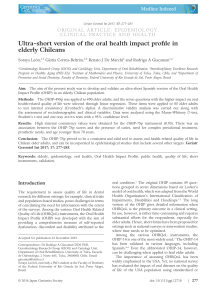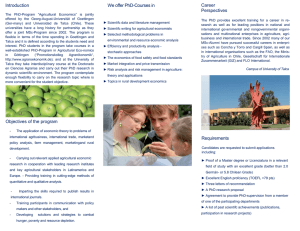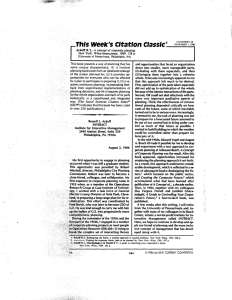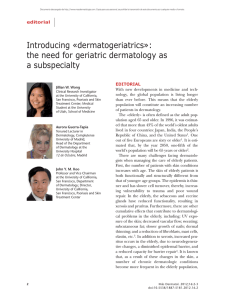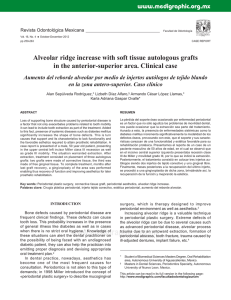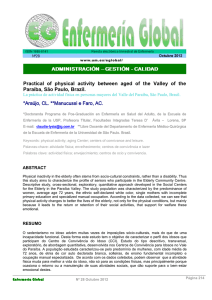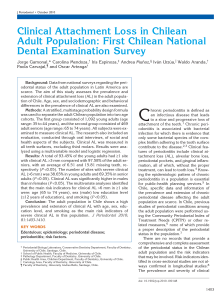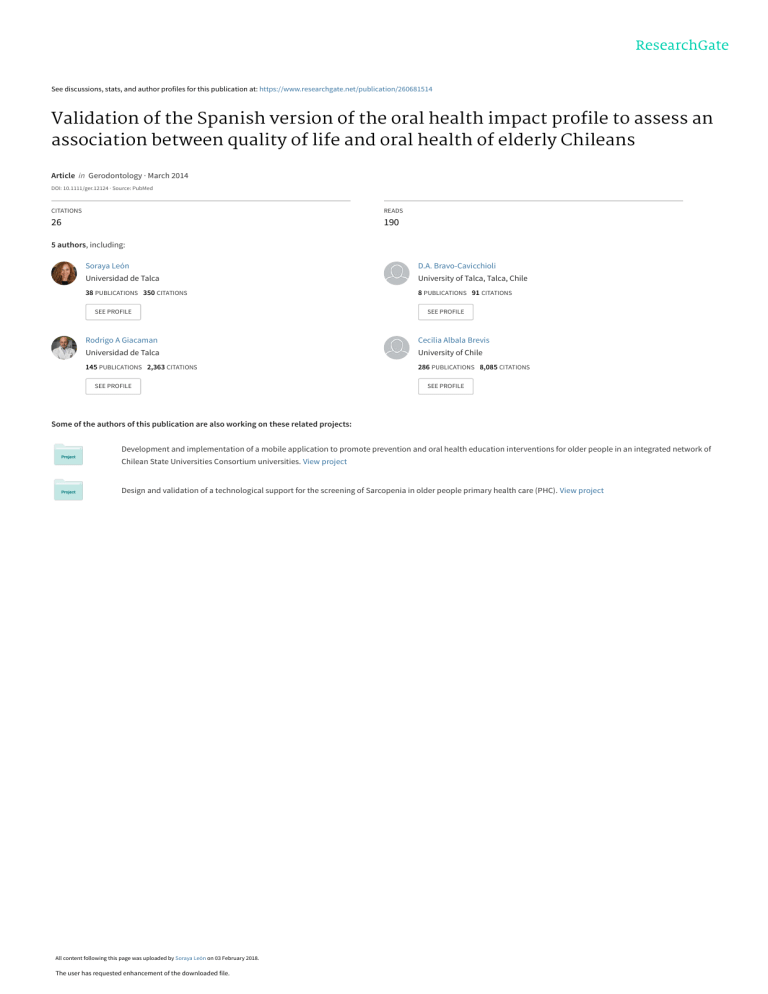
See discussions, stats, and author profiles for this publication at: https://www.researchgate.net/publication/260681514 Validation of the Spanish version of the oral health impact profile to assess an association between quality of life and oral health of elderly Chileans Article in Gerodontology · March 2014 DOI: 10.1111/ger.12124 · Source: PubMed CITATIONS READS 26 190 5 authors, including: Soraya León D.A. Bravo-Cavicchioli Universidad de Talca University of Talca, Talca, Chile 38 PUBLICATIONS 350 CITATIONS 8 PUBLICATIONS 91 CITATIONS SEE PROFILE SEE PROFILE Rodrigo A Giacaman Cecilia Albala Brevis Universidad de Talca University of Chile 145 PUBLICATIONS 2,363 CITATIONS 286 PUBLICATIONS 8,085 CITATIONS SEE PROFILE SEE PROFILE Some of the authors of this publication are also working on these related projects: Development and implementation of a mobile application to promote prevention and oral health education interventions for older people in an integrated network of Chilean State Universities Consortium universities. View project Design and validation of a technological support for the screening of Sarcopenia in older people primary health care (PHC). View project All content following this page was uploaded by Soraya León on 03 February 2018. The user has requested enhancement of the downloaded file. Original article Validation of the Spanish version of the oral health impact profile to assess an association between quality of life and oral health of elderly Chileans n1,2, Daniel Bravo-Cavicchioli1,2, Rodrigo A. Giacaman1,2, Gloria Correa-Beltra n3 Soraya Leo and Cecilia Albala4 1 Department of Oral Rehabilitation, University of Talca, Talca, Chile; 2Interdisciplinary Excellence Research Program on Healthy Aging (PIEI-ES), University of Talca, Talca, Chile; 3Institute of Mathematics and Physics, University of Talca, Talca, Chile; 4Institute of Nutrition and Food Technology, University of Chile, Santiago, Chile Gerodontology 2014; doi: 10.1111/ger.12124 Validation of the Spanish version of the oral health impact profile to assess an association between quality of life and oral health of elderly Chileans Objective: To validate the Spanish version of the OHIP-49 among elderly population. Background: Oral health, as a predictor of quality of life, can be evaluated using validated instruments. One of the most commonly used instruments worldwide is the Oral Health Impact Profile-49 (OHIP-49). This instrument has not yet been validated in Chilean older adults. Materials and methods: Interviews and clinical exams were performed in a convenience sample of eighty-five elderly participants aged 60 or more years (mean 69.02 7.82 years). Socio-demographic and clinical variables were analysed: number of teeth, caries, periodontal and prosthetic treatment needs and prosthetic functionality. Results: High internal consistency values were obtained for both the OHIP-49 Sp instrument (0.990) and all of its dimensions (0.875–0.995). The average score of the OHIP-49 Sp was 62.54 43.73. Significantly higher OHIP-49 Sp scores were observed in participants with caries (p = 0.01), in those needing complex periodontal treatment (p = 0.0001) and those in need of dental prostheses (p ≤ 0.0001). Conclusion: The OHIP-49 Sp proved to be a valid tool to assess oral health-related quality of life, when tested in Chilean older adults. Keywords: quality of life, oral health, oral health impact profile, validation studies as topic, aged, chile. Accepted 10 February 2014 Introduction From the first studies in the seventies1, several reports have conveyed a psychosocial component of oral diseases. Many researchers have demonstrated that oral diseases have emotional and psycho-social consequences, such as isolation, unemployment and depression, which are as serious as other common disease2–4. As a consequence, therefore, oral conditions may compromise quality of life. Indeed, quality of life related to oral health (OHRQoL) is conceived as a multidimensional evaluation of the impact of the oral status on everyday activities. OHRQoL is becoming increasingly used to assess oral health, oral treatment needs and the outcomes of dental treatment in general and elderly population5,6. Some, but not all, indicators used to evaluate the impact of the OHRQoL are based on the conceptual framework of the International Classification of Impairments, Disabilities and Handicaps (ICIDH)7. Further, Locker adapted the ICIDH model for use in oral health and described a conceptual framework for this purpose8. Thus, a new instrument was developed to evaluate OHRQoL, known as the Oral Health Impact Profile (OHIP)9. Translated to several languages10–16 and used in several countries17,18, the OHIP is one of the most widely used instruments to assess OHRQoL. This instrument intends to assess the impact of oral health on quality of life. A higher OHIP score is interpreted as having higher negative impact on quality of life18. © 2014 John Wiley & Sons A/S and The Gerodontology Association. Published by John Wiley & Sons Ltd 1 2 S. Leon et al. Among the various idiomatic translations of the instrument, Spanish version of the OHIP in elderly populations demonstrated a high internal consistency and reproducibility in a Mexican population12. In Chile, a language-adapted version of the OHIP was used in adolescents16, showing high internal consistency. The OHIP, on the other hand, has not been validated in a population of older adults. This population may interpret the questions contained in the instrument differently. Many of the questions are related with the use of prosthesis or with complications associated with tooth loss, which are less prevalent in adolescents. As a cultural trait, language used in Spanish to address a youngster is more colloquial than that used to talk with an elder. Older adults, therefore, may have different results using this survey and that provides support to the need of validating the instrument in this particular age group. Like many other Latin American countries, Chile has a rapidly ageing population19. It is important, therefore, to comprehensively assess oral health status of this growing population, including OHRQoL. To achieve validity of the results in the studied population and to assure that the appropriate psychometric properties are measured, each question of the instrument must be carefully translated and then adapted18. The purpose of this study, therefore, was to validate the Spanish version of the OHIP-49 in an elderly Chilean population using convergent validity. A negative OHRQoL was expected to be found in this population, as it has been demonstrated in previous studies that poor oral health status is directly associated with worse OHRQoL in the elderly population20. Materials and methods Discriminating cross-validation of the diagnostic instrument, the OHIP-49 Sp was performed on a group of older adults from Chile. Using an unpublished face validated the OHIP-49 Sp questionnaire (Torres, 2009, personal communication), a pilot study was performed to assess language comprehension. From the results, three questions needed to be adapted. Sample group and study variables A sample of eighty-five participants of 60 years of age or older were selected from the Dental Clinics of the School of Dentistry of the University of Talca, private practices, senior social clubs and primary healthcare centres. Different sources of participants were used to avoid the bias of only surveying people seeking oral health care. Participants were excluded from the study if they showed signs of cognitive impairment or alcoholism. After receiving detailed information about the project and signing an informed consent to participate in the study, the participants completed a survey about their socio-demographic background and health history. Participants also completed the OHIP and received a complete dental examination from two calibrated dentists. Participants were informed of their oral health status and received oral hygiene instruction. Furthermore, each participant received a dental hygiene kit. The study and the informed consent form were approved by the Bioethics Committee of the University of Talca. Sample size was calculated using an expected correlation coefficient of 0.30 between oral variables and the results of the OHIP-4912. For an R = 0.30 with a strength of 80% (b = 0.20) and a significance of 0.05 (two tailed a = 0.05), a total of eighty-five participants were required. Oral health impact profile (OHIP) The English version of the OHIP consists of fortynine items divided into seven dimensions21 and hierarchically organised according to the complexity of each item. While the first dimensions measure pain and functional limitations associated with oral health, the final questions are more closely related to the impact of oral health on every day activities and social roles6,17. The final score of the OHIP-49 Sp is obtained from the sum of the scores obtained from each of the seven dimensions analysed6: functional limitation (0–36), physical pain (0–36), psychological discomfort (0–20), physical disability (0–36), psychological disability (0– 24), social disability (0–20) and handicap (0–24). Therefore, values can range from 0 to 196 points. A language comprehension pilot test was carried out before the main study with twenty randomly selected elderly people. When the participants expressed confusion with the meaning or the examiners noticed it, the question was interpreted as requiring a modification. To facilitate further comprehension of those conflicting questions, participants were required to provide an alternative phrasing. From the pilot study, three questions needed to be modified to facilitate interpretation: Question 7 ‘Have you had food catching in your teeth or dentures?’ was replaced by the phrase ‘Has food gotten caught between your teeth or beneath your denture?’, Question 21 ‘Have dental problems made you miserable?’ was replaced by © 2014 John Wiley & Sons A/S and The Gerodontology Association. Published by John Wiley & Sons Ltd Validation of the Spanish version of OHIP-49 the same phrase used in the validation instrument in Mexico12 ‘Have dental problems made you feel completely unhappy?’ and Question 45 ‘Have you suffered any financial loss because of problems with your teeth, mouth or dentures?’ was replaced by ‘Have you suffered any type of economic loss due to problems with your teeth, mouth or prostheses?’ Finally, this new modified version was administered to a different group of 20 elderly participants from the same socio-economic background who had not participated previously in the pilot study. These participants had no problems understanding the meaning or the vocabulary in the rephrased questions. Data collection The study took place between July and October, 2011. During the interviews, the participants answered the previously piloted version of the OHIP-49 Sp, as well as the questions about their socio-demographic background. Furthermore, participants underwent a clinical exam, which included several oral variables. To test for discriminant validity, each of the variables was categorised as follows: number of teeth: 20–28, 10–19, 1–9 or edentate; presence of caries lesions: no or yes according to WHO’s criteria22; Community Periodontal Index of Treatment Needs (CPITN)23: simple periodontal treatment (TN2) or complex periodontal treatment (TN3); prosthetic need: no or yes and Functional Assessment of Dentures (FAD)24: high or low (Table 4). The surveys and clinical exams were carried out in the locations in which the participants were enroled in the study. Clinical examinations were performed by two dentists who were calibrated in the oral variables in study. The dentists alternated between administering the survey and carrying out the dental exam of the participants, so that the researcher who administered the OHIP-49 Sp was blind for the results of the clinical examination and vice versa. An interexaminer calibration was performed in twenty older adults that regularly attended the Dental Clinics of the School of Dentistry of the University of Talca and under the same conditions used in the main study. The examiners were calibrated on the CPITN, caries detection and FAD. A Kappa score for all the calibration of 0.76 was obtained. Statistical analysis Mean, standard deviation, range and confidence interval at 95% and percentile distributions were 3 calculated for the baseline description. After standardising clinical measurements, high values of agreement were attained between examiners (Kappa Index 0.76). Cronbach’s a was used to assess the internal consistency coefficient while the convergent validity (q) was established by Spearman rank correlation. Depending on the type of variable, either Mann–Whitney (W), Student’s t (T), one-way ANOVA parametric (F) or nonparametric Kruskal Wallis (H) tests were used in order to determine the discriminative validity of the mean or median scores of each dimension and the complete instrument with the clinical variables. The OHIP-49 Sp total score was used as the dependent variable, and the socio-demographic and clinical as the independent ones. An initial univariate analysis sought to detect differences between the group of dentate and edentulous people, followed by a multivariate analysis within each group. A stepwise procedure was conducted to exclude non-significant variables. Poisson regression was performed to test the association of the dependent with the significant independent variables. Prevalence ratio and the confidence interval were used as the outcome of the model. The percentile 25 was used as the cutoff point for good oral health-related quality of life. Above that score, OHRQoL was considered as poor. Statistical analysis was performed using SPSS v15.0 (IBM Corporation, Somers, NY, USA). Results Socio-demographic and clinical variables are shown in Table 1. While 61.18% of the participants were female, 38.82% were male. The average age was 69.02 7.82 years, and 32.94% of the participants had between 20 and 28 teeth. Among those participants having at least one tooth, 52.9% had at least one carious lesion and 100% required periodontal treatment, either simple or complex. 74.12% of the participants needed a complete or partial removable denture, and between those already wearing one, 65.5% had poor functionality. High variability was observed in the OHIP-49 Sp scores (Table 2). Psychological discomfort dimension reached the highest possible value. Among all the dimensions, the lowest values were observed in the social disability and handicap dimensions with a score of 2 and 3, respectively. The internal consistency of the seven dimensions was high, with all values of Cronbrach’s a coefficient higher than 0.875, resulting in a general internal consistency for the entire instrument © 2014 John Wiley & Sons A/S and The Gerodontology Association. Published by John Wiley & Sons Ltd 4 S. Leon et al. Table 1 Socio-demographic and clinical characteristics of the study population of older adults. Variable Gender Age Educational level (years) Socio-economic status Systemic conditions Smoking habit Number of teeth Carious lesions CPITN Prosthetic need Prosthetic functionality Women Men 60–69 70 o+ >12 9–12 ≤8 Upper Middle Lower ≤2 ≥3 Yes Not nowadays Never 20–28 10–19 1–9 Edentate No Yes TN2 TN3 No Yes High Low n (%) 52 33 52 33 16 22 47 3 55 27 61 24 15 29 41 28 19 15 23 17 45 31 31 22 63 19 36 61.18 38.82 61.18 38.8 18.82 25.88 55.29 3.5 64.7 31.76 71.76 28.24 17.6 34.1 48.2 32.94 22.35 17.65 27.06 47.1 52.9 50 50 25.88 74.12 34.5 65.5 of 0.990 (Table 3). On the other hand, convergent validity showed a significant correlation between carious lesions with functional limitation, psychological discomfort, handicap, psychological disability, social disability and the OHIP-49 Sp global values (p = 0.01). All the dimensions and the OHIP-49 Sp global values showed a significant correlation with CPITN (p < 0.05). In all the OHIP-49 Sp dimensions, a higher score was significantly correlated with having prosthetic needs (p < 0.05). Likewise, worse OHIP-49 scores in all dimensions were correlated with lower functionality of the upper and lower prosthesis (p < 0.05), exception made for physical disability, handicap and the OHIP-49 global score (p > 0.05). Although discriminative validity tests failed to show an association between number of remaining teeth and any dimension of the OHIP-49 Sp, most dimensions were associated with caries (p < 0.05), except physical pain and handicap. The CPITN showed a very strong association with all the dimensions of the instrument at TN3 (p < 0.0001). Similar significant associations were obtained with those participants needing new dentures (p < 0.0001). Regarding denture functionality, the OHIP-49 Sp was associated with poor functionality of the upper and lower prostheses (p < 0.05), except for the physical disability, handicap and the global OHIP-49 Sp score (p > 0.05) (Table 4). Except for the physical pain dimension, a significant association between the OHIP-49 Sp test and its dimensions was found in the younger age group (between 60 and 69 years of age) (Table 5). After selecting the significant clinical variables through a stepwise procedure, two Poisson regression models were constructed, for dentate and edentulous participants. The models showed that dentate elderly participants with carious lesions had 2.3-fold higher risk of having poor quality of life than those without lesions. Furthermore, those participants who had needs for complex periodontal treatment showed 1.3-fold higher risk of having poor quality of life, as compared with those with less complex periodontal treatment needs. Edentulous participants with poor lower denture functionality had 1.5-fold more risk of a Table 2 Total Spanish version of the Oral Health Impact Prolife-49 (OHIP-49 Sp) scores for each dimension in the population of older adults studied. Dimension Maximum possible Minimum observed Maximum observed Mean SD Median Quartile 1 Quartile 3 Functional limitation Physical pain Psychological discomfort Physical disability Psychological disability Social disability Handicap Global 36 36 20 36 24 20 24 196 0 0 0 0 0 0 0 2 34 32 20 35 23 17 22 163 14.58 11.31 9.56 10.64 7.62 3.73 5.11 62.54 9.37 8.13 5.83 9.08 6.69 4.47 6.06 43.73 15 10 9 8 6 2 3 55 7 4 5 3 2 0 0 25 21 18 15 19 12 6 8 97 © 2014 John Wiley & Sons A/S and The Gerodontology Association. Published by John Wiley & Sons Ltd Validation of the Spanish version of OHIP-49 Table 3 Internal consistency rating of the Spanish version of the Oral Health Impact Prolife-49 (OHIP-49 Sp) and each of its dimensions for all the older adults analysed. Dimension Number of items Cronbach’s alfa Functional limitation Physical pain Psychological discomfort Physical disability Psychological disability Social disability Handicap Global 9 9 5 9 6 5 6 49 0.875 0.960 0.964 0.989 0.992 0.993 0.995 0.990 poor quality of life than those with functional prostheses. Finally, elderly participants needing a denture had 0.4-fold increased risk of poor quality of life than those without prosthetic needs (Table 6). Discussion Results from this study validate the Spanish version of the OHIP-49 as a valid instrument to assess OHRQoL in elderly Chileans. This instrument had also been previously validated in other Latin American countries12,14. Herein, clinical variables were similar to those used in other studies6,12,18,25. We decided to additionally include prosthetic functionality24, nevertheless. As Chilean elders are largely a partial or edentulous population20, this variable appears pertinent and relevant to be included. When requested to answer the questionnaire, patients were instructed to remember their selfperception from last year. This may seem inappropriate because people may tend to forget. A time frame of one year or one month is frequently used for these types of study. Although participants tend to use their most recent experiences and opinions to extrapolate to the period of one year, a study showed no difference in the results of the OHIP-49 applied by recalls of one month or one year11. A Likert-type scale was used here. This ordinal scale has been shown to be valid as a response scale for this kind of survey26. The quantitative method of the OHIP-49 used in this study, with values between 0 and 196 points, has demonstrated excellent discriminative ability in other studies14,27,28. The high internal consistency demonstrated by the instrument as a whole (Cronbach’s a = 0.990) and in each of its 7 dimensions (Cronbach’s 5 a > 0.875) was higher than that originally reported by Slade and Spencer with the original study6 and other studies11,12,15,29,30, but it was similar to results obtained by other authors10,13. Yet, Cronbach’s a coefficient values higher than 0.6 indicate that the instrument has a high internal consistency31. Both ranges and median scores obtained in this study were similar to those found in other studies carried out in elderly populations using the additive method as well as the OHIP-49 median scores. Interestingly, social disability and handicap dimensions presented the lowest mean and median scores. This could be due to the fact that people may not consciously consider oral health as having an impact on their social activities. According to Slade et al.32, this perception could be influenced by a number of factors from the participants’s educational or socio-economic level to social and cultural norms and characteristics due to the strong influence they have on the decision to seek dental care. Furthermore, it is possible that some of the cultural factors that influence perception of the impact of oral health on social relationships are closely linked to differences in social behaviours and norms. Thus, how oral health is represented in particular societies will depend on social norms and conceptions12. Studies carried out in the Latin American region, including Chile20 as well as Uruguay and Argentina33, have reported that poor oral health, aggravated by poor quality of life, is associated with inequalities in education and socio-economic level. On the other hand, several authors have found differences between oral care needs identified by a professional and those self-perceived by older adults5. In fact, it is known that many gastrointestinal disorders arise due to oral disease and denture problems34,35. Still, many elderly people seem unaware of this relation, or they consider it as part of the ageing process. Indeed, people who think they need dental care are usually those with actual oral health problems affecting their quality of life36,37. The latter underlines an educative role for dentists as health promoters. The role played by dental professionals as mere therapeutic providers needs to be changed for a more actively engaged professional in health education, promotion and prevention. When evaluating the convergent validity based on clinical variables (Table 6), the most robust associations were observed between the presence of carious lesions, the need of periodontal treatment (TN3) and of a new denture. Unlike a recent systematic review of the literature and meta- © 2014 John Wiley & Sons A/S and The Gerodontology Association. Published by John Wiley & Sons Ltd 6 S. Leon et al. Table 4 Mean comparison of the different oral variables included within each of the dimensions of the Spanish version of the Oral Health Impact Prolife-49 (OHIP-49 Sp). Mean (SD), median. Dimension Variable 20–28 (n = 28) 10–19 (n = 19) 1–9 (n = 15) Edentate (n = 23) p No (n = 17) Yes (n = 45) Functional limitation Physical pain Number of teeth 9.79 12.96 (8.06) (7.63) 9 11 10.63 11.63 (9.6) (10.3) 8 9 15.53 20 (7.69) (11.33) 18 23 Psychological discomfort Physical disability Psychological disability Social disability Handicap OHIP-49 Sp 9.75 (5.68) 10.5 8.68 (6.66) 6 12.53 (6.56) 15 8.43 (9) 4.5 7.95 (9.23) 5 16.13 (8.53) 19 6.71 (6.58) 5 7.26 (7.61) 4 10.87 (6.69) 11 3.71 (4.91) 2 2.89 (4.01) 1 5.4 (5.37) 4 4.61 (6.49) 1.5 3.89 (5.63) 0 7.93 (6.51) 5 55.96 (41.53) 46.5 52.95 (50.38) 34 88.4 (45.8) 98 10.96 15.43 (6.63) (7.97) 11 16 0.2 0.4 Caries lesion 8 8.41 (9.35) (7.21) 4 8 8.13 (4.22) 7 0.1 11.96 (8.01) 11 0.4 6.91 (5.76) 6 0.6 3.35 (3.54) 2 0.7 4.87 (5.34) 4 0.8 61.61 (34.36) 60 0.4 7.29 (6.11) 6 6.29 (8.97) 2 5 (6.51) 3 2.53 (5) 0 3.24 (6.17) 0 40.76 (46.47) 20 12.58 (8.96) 10 11.16 (6.07) 11 11.6 (9.32) 8 8.98 (6.98) 8 4.38 (4.66) 3 5.93 (6.32) 4 71.24 (44.87) 68 0.1 0.02 0.03 0.02 0.02 0.08 0.01 9.29 (8.12) 8 8.23 (6.06) 7 7.16 (8.55) 3 5.13 (5.94) 4 2.23 (3.84) 0 2.97 (5.08) 0 46.23 (42.08) 36 16.62 (9) 16 p 0.0009 CPITN TN2 11.23 (n = 31) (9.54) 10 13.58 17.29 (8.79) (9.39) 13 18 <0.0001 <0.0001 Prosthetic need 7.05 7.14 (5.5) (5.72) 7 7.5 11.97 (6.01) 12 <0.0001 13.13 (9.5) 16 <0.0001 10.65 (7.04) 11 <0.0001 5.52 (5.12) 5 <0.0001 7.42 (6.77) 5 <0.0001 79.55 (46.29) 92 <0.0001 6.82 (4.98) 6 4.27 (5.03) 3 3.23 (2.98) 2.5 1.27 (2.21) 0 1.41 (2.72) 0 31.18 (25.05) 28.5 Yes (n = 63) 17.21 (9.03) 18 12.76 (8.38) 12 10.52 (5.84) 11 12.86 (9.15) 13 9.16 (6.96) 7 4.59 (4.74) 3 6.4 (6.38) 4 73.49 (43.67) 76 p <0.0001 0.006 Upper functionality 11.29 8.65 (9.85) (6.9) 10 9 0.009 <0.0001 0.0003 0.0007 0.0002 <0.0001 8.76 (5.53) 10 7.41 (7.03) 6 5.65 (4.94) 4 2.41 (2.21) 2 3.47 (3.94) 2 47.65 (36.2) 39 TN3 (n = 31) p No (n = 22) High (n = 17) (continued) © 2014 John Wiley & Sons A/S and The Gerodontology Association. Published by John Wiley & Sons Ltd Validation of the Spanish version of OHIP-49 7 Table 4 (Continued) Dimension Variable Low (n = 35) p High (n = 7) Low (n = 22) p Functional limitation Physical pain 14.17 18.09 (8.29) (9.42) 13 19 0.02 0.02 Lower functionality 6.71 8.57 (9.89) (11.07) 2 4 18.27 12.91 (10.75) (8.88) 18 11 <0.0001 <0.0001 Psychological discomfort Physical disability Psychological disability Social disability Handicap OHIP-49 Sp 9.69 (6) 7 <0.0001 14.23 (8.94) 17 <0.0001 9.23 (7.38) 7 <0.0001 4.63 (5.03) 3 <0.0001 6.49 (6.75) 4 <0.0001 76.51 (46.25) 82 0.02 6.57 (7.16) 5 9.36 (6.53) 7 <0.0001 5.86 (6.36) 3 13.82 (10.16) 12.5 0.0627 4.86 (7.73) 2 8.73 (7.64) 6 <0.0001 2.71 (5.31) 0 4.27 (5.35) 2 <0.0001 2.57 (4.83) 0 6.64 (7.45) 4 0.2786 37.86 (51.25) 14 74 (50.95) 61.5 0.1057 Table 5 Mean comparison of the age as determinant for oral health-related quality of life in all the dimensions of the Spanish version of the Oral Health Impact Prolife-49 (OHIP-49 Sp). Mean (SD), median. Dimension Age 60–69 (n = 52) 70 and + (n = 33) p Functional limitation Physical pain Psychological discomfort Physical disability Psychological disability Social disability Handicap OHIP-49 Sp 16.33 (9.56) 16.5 11.82 (8.48) 11 0.03 12.54 (8.9) 10 9.36 (6.4) 10 0.2 11.19 (5.99) 11.5 7 (4.6) 6 0.002 12.12 (9.54) 8 8.3 (7.88) 6 0.05 9.65 (7.31) 8 4.42 (3.88) 4 0.001 4.88 (4.98) 3.5 1.91 (2.71) 1 0.005 6.73 (6.89) 4.5 2.55 (3.08) 2 0.01 73.44 (47.22) 72.5 45.36 (31.12) 44 0.008 analysis38, we did not find a strong association with the number of remaining teeth. Reasons for these findings may arise from the fact that elders with few teeth probably wore dentures. So, even if they were not functional, self-perception of quality of life was better explained by having an aesthetically acceptable prosthesis and it is unaffected by the lack of teeth. The results of the discriminate validity tests demonstrated that caries had a pronounced impact on the quality of life. Conversely, a previous study reported otherwise32. We believe that this finding highlights the importance of assessing OHRQoL in different countries or communities. From our results, it appears clear that Chileans’ self-perception of oral health and its relation with quality of life cannot be extrapolated from results obtained in different populations. Other significant associations were found with complex periodontal treatment need (TN3). Advanced stages of periodontal disease involve recessions, hypersensi- tivity, tooth mobility, pain, swelling, bleeding, aesthetic and phonetic implications, among others39. These collateral effects from advanced periodontal disease may explain the association between poor quality of life and dental caries, and complex periodontal treatment need (TN3) found in this study. Prosthetic needs and wearing a nonfunctional apparatus were associated with quality of life (Table 6). Reasons may derive from loss of oral function and aesthetic compromise. Nonfunctional dentures may induce pain, discomfort, chewing and speaking difficulties40. Lack of teeth or their prosthetic replacement may lead to insecurities and social isolation compromising quality of life. On an interesting finding, quality of life was more affected in elderly adults of 60–69 years old than older participants (Table 5). Older cohorts suffer the cumulative effects of life-long oral conditions, such as dental caries or periodontal disease leading to tooth loss. Hence, as people grow older, they may start to consider oral © 2014 John Wiley & Sons A/S and The Gerodontology Association. Published by John Wiley & Sons Ltd 8 S. Leon et al. Table 6 Poisson regression model for CPITN, caries, lower prosthetic functionality and prosthetic need as predictors of poor oral health-related quality of life using the Spanish version of the Oral Health Impact Prolife-49 (OHIP-49 Sp). Prevalence ratio (PR) was the estimator with a cut-off for poor oral health-related quality of life fixed at percentile 25. Variable Standard error b CPITNa 0.3028 0.1515 Cariesa 0.8355 0.3173 Lower functionaliyb Prosthetic needsb 0.4055 0.1826 0.8109 0.3651 PR (IC 95%) 1.354 (1.006–1.822) 2.306 (1.238–4.295) 1.50 (1.049–2.453) 0.44 (0.217–0.909) a Model considered only participants with teeth. b Model considered only edentulous participants. mutilation as an unavoidable consequence of ageing. In that scenario, a lower impact on OHRQoL can be expected. Although we acknowledge that a relatively small sample of edentulous participants may comprise bias, most of the analyses shown here were carried out on those bearing teeth, which was more numerous than the group of edentulous people. There is a possibility of bias from the selection of the sample as participants came from different settings. While some of them were care-seekers, either public or private, others were members of senior social clubs. Yet, this decision was made intentionally, as we sought to References 1. Cohen LK, Jago JD. Toward the formulation of sociodental indicators. Int J Health Serv 1976; 6 : 681–98. 2. Reisine ST. Dental disease and work loss. J Dent Res 1984; 63 : 1158–61. 3. Gift HC, Reisine ST, Larach DC. The social impact of dental problems and visits. Am J Public Health 1992; 82 : 1663–8. 4. Reisine ST, Fertig J, Weber J, Leder S. Impact of dental conditions on patients’ quality of life. Community Dent Oral Epidemiol 1989; 17 : 7–10. 5. Kressin N. The Oral Health Related Quality of Life Measure (OHQOL). In: Slade G ed. Measuring Oral Health and Quality of Life. Chapel Hill: University of North Carolina, 1997: 114–9. include more diversity within the participants, including educational level and sociocultural status. The fact that more women were prone to participate is expected this type of study with older adults. A risk of reporting bias may arise from a long questionnaire of forty-nine questions. From the data of this study, it is not possible to explore the possibility of fatigue or loss of concentration in answering, but it certainly should be taken into account when evaluating the results. Thus, an abbreviated version of this tool, particularly for this population, seems appealing, and it should be considering in further investigations. Conclusions This study confirmed that the OHIP-49 Sp is a valid instrument when used in Chilean older adults. Carious lesions, the need for complex periodontal treatment, prosthetic needs and the use of non-functional prostheses appear to be associated with higher OHIP-49 Sp scores. A deteriorated oral health decidedly influences quality of life. From the present study, the impact of oral conditions on quality of life in other Chilean specific populations can be examined using the validated the OHIP-49 Sp. Conflict of interest The authors declare no conflict of interest. 6. Slade GD, Spencer AJ. Development and evaluation of the oral health impact profile. Community Dent Health 1994; 11 : 3–11. 7. Organization WH. International classification of impairments, disabilities and handicaps. Geneva; 1980 Contract No.: Document Number. 8. Locker D. Measuring oral health: a conceptual framework. Community Dent Health 1988; 5 : 3–18. 9. Slade GD, Strauss RP, Atchison KA, Kressin NR, Locker D, Reisine ST. Conference summary: assessing oral health outcomes–measuring health status and quality of life. Community Dent Health 1998; 15 : 3–7. 10. van der Meulen MJ, John MT, Naeije M, Lobbezoo F. The Dutch version of the oral health impact profile (OHIP-NL): translation, reli- 11. 12. 13. 14. ability and construct validity. BMC Oral Health 2008; 8: 11. John MT, Patrick DL, Slade GD. The German version of the oral health impact profile–translation and psychometric properties. Eur J Oral Sci 2002; 110 : 425–33. Castrej on-P erez RC, Borges~ ez SA, Irigoyen-Camacho Y an ME. Validation of an instrument for measuring the effects of oral health on the quality of life of older adults in Mexico. Rev Panam Salud Publica 2010; 27 : 321–9. Kuo HC, Chen JH, Wu JH, Chou TM, Yang YH. Application of the oral health impact profile (OHIP) among Taiwanese elderly. Qual Life Res 2011; 20 : 1707–13. Pires CPdAB, Ferraz MB, Abreu MHNGd. Translation into Brazilian portuguese, cultural adaptation and © 2014 John Wiley & Sons A/S and The Gerodontology Association. Published by John Wiley & Sons Ltd Validation of the Spanish version of OHIP-49 validation of the oral health impact profile (OHIP-49). Braz Oral Res 2006; 20: 263–8. 15. Liu JY, Pow EH, Chen ZF, Zheng J, Zhang XC, Chen J. The Mandarin Chinese shortened version of oral health impact profile for partially edentate patients with implant-supported prostheses. J Oral Rehabil 2012; 39 : 591–9. 16. Lopez R, Baelum V. Spanish version of the oral health impact profile (OHIP-Sp). BMC Oral Health 2006; 6: 11. 17. Slade GD. Oral Health Impact Profile. In: Slade GD ed. Measuring Oral Health and Quality of Life. Chapel Hill: University of North Carolina, 1997: 93–104. 18. Bae KH, Kim HD, Jung SH, Park DY, Kim JB, Paik DI et al. Validation of the Korean version of the oral health impact profile among the Korean elderly. Community Dent Oral Epidemiol 2007; 35 : 73–9. 19. INE, Chile. Censo 2012. Available at: http://www.censo.cl/2012/08/resultados_preliminares_censo_2012.pdf (last accessed 8 October 2012). 20. Mari~ no R, Albala C, Sanchez H, Cea X, Fuentes A. Self-assessed oral-health status and quality of life of older Chilean. Arch Gerontol Geriatr 2013; 56 : 513–7. 21. Patrick DL, Bergner M. Measurement of health status in the 1990s. Annu Rev Public Health 1990; 11: 165–83. 22. Organization WH. Oral Health Surveys Basic Methods. 4Th Edition ed. Geneva; 1997. 23. Ainamo J, Barmes D, Beagrie G, Cutress T, Martin J, Sardo-Infirri J. Development of the world health organization (WHO) community periodontal index of treatment needs (CPITN). Int Dent J 1982; 32 : 281–91. 24. Anastassiadou V, Katsouli S, Heath MR, Pissiotis A, Kapari D. 25. 26. 27. 28. 29. 30. 31. 32. 33. Validation of communication between elderly denture wearers and dentists: a questionnaire on satisfaction with complete dentures using semi-structured interviews. Gerodontology 2004; 21 : 195–200. Yamazaki M, Inukai M, Baba K, John MT. Japanese version of the oral health impact profile (OHIP-J). J Oral Rehabil 2007; 34 : 159–68. Sierwald I, John MT, Durham J, Mirzakhanian C, Reissmann DR. Validation of the response format of the oral health impact profile. Eur J Oral Sci 2011; 119 : 489–96. Rener-Sitar K, Petricevic N, Celebic A, Marion L. Psychometric properties of Croatian and Slovenian short form of oral health impact profile questionnaires. Croat Med J 2008; 49 : 536–44. Robinson PG, Gibson B, Khan FA, Birnbaum W. Validity of two oral health-related quality of life measures. Community Dent Oral Epidemiol 2003; 31 : 90–9. Wong MC, Lo EC, McMillan AS. Validation of a Chinese version of the oral health impact profile (OHIP). Community Dent Oral Epidemiol 2002; 30 : 423–30. Kenig N, Nikolovska J. Assessing the psychometric characteristics of the Macedonian version of the oral health impact profile questionnaire (OHIP-MAC49). Oral Health Dent Manag 2012; 11 : 29–38. Bland JM, Altman DG. Cronbach’s alpha. BMJ 1997; 314 : 572. Slade GD, Spencer AJ, Locker D, Hunt RJ, Strauss RP, Beck JD. Variations in the social impact of oral conditions among older adults in South Australia, Ontario, and North Carolina. J Dent Res 1996; 75 : 1439–50. Fuentes-Garcıa A, Lera L, S anchez H, Albala C. Oral healthrelated quality of life of older people 34. 35. 36. 37. 38. 39. 40. from three South American cities. Gerodontology 2013; 30 : 67–75. Walls AW, Steele JG, Sheiham A, Marcenes W, Moynihan PJ. Oral health and nutrition in older people. J Public Health Dent 2000; 60 : 304–7. Smith JM, Sheiham A. How dental conditions handicap the elderly. Community Dent Oral Epidemiol 1979; 7 : 305–10. Maupom e G, MacEntee MI. Prosthodontic profiles relating to economic status, social network, and social support in an elderly population living independently in Canada. J Prosthet Dent 1998; 80 : 598–604. Colussi CF, De Freitas SF, Calvo MC. The prosthetic need WHO index: a comparison between selfperception and professional assessment in an elderly population. Gerodontology 2009; 26 : 187–92. Gerritsen AE, Allen PF, Witter DJ, Bronkhorst EM, Creugers NH. Tooth loss and oral healthrelated quality of life: a systematic review and meta-analysis. Health Qual Life Outcomes 2010; 8: 126. Boehm TK, Scannapieco FA. The epidemiology, consequences and management of periodontal disease in older adults. J Am Dent Assoc 2007; 138 (Suppl): 26S–33S. Preshaw PM, Walls AW, Jakubovics NS, Moynihan PJ, Jepson NJ, Loewy Z. Association of removable partial denture use with oral and systemic health. J Dent 2011; 39 : 711–9. Correspondence to: Rodrigo A. Giacaman, Escuela de Odontologıa, 2 Norte 685, Talca, Chile. Tel.: 56 71 201546 Fax: 56 71 201761 E-mail: giacaman@utalca.cl © 2014 John Wiley & Sons A/S and The Gerodontology Association. Published by John Wiley & Sons Ltd View publication stats 9
